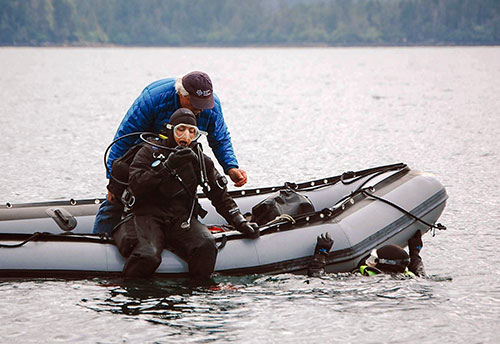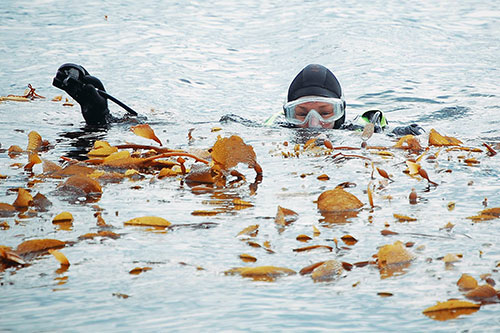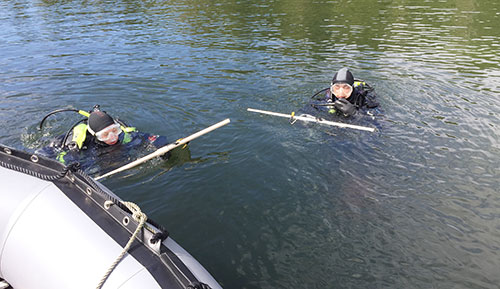
Sitka Sound abalone and kelp: Looking for answersDiscussions to expand research to an area near KetchikanBy LAUREN FRISCH
November 29, 2015
Project leaders are simultaneously answering basic questions about kelp and abalone while developing a long-term monitoring system to track how the species are changing.
Lauren Bell gets ready to count and measure abalone.
Kelp beds are tall underwater forests that protect shorelines from storms. Kelp also protect a wide range of sea life from turbulent wave activity by serving as a nursery for sensitive invertebrates and fish. Projected increases in both water temperatures and the intensity and frequency of coastal storms could damage kelp, and over time make it more difficult for kelp beds to remain large enough to protect shorelines and biodiversity. Without kelp along rocky coastlines, animals like pinto abalone could become more vulnerable to storm activity and other external pressures. Pinto abalone are the large edible sea snails that live and feed on Southeast Alaska kelp beds. Pinto abalone were once widespread and common in Sitka Sound, but populations began to decline in the mid-1960s when introduced sea otter populations started increasing, and continued to decline as the species became available for commercial fishing in the 1970s. It became much harder to find pinto abalone in Sitka Sound, resulting in a ban on commercial fishing in 1996. In 2012, sport fishing was closed for pinto abalone and stringent subsistence rules were put into place.
Taylor White finishes up a dive.
“Kelp and abalone are the species people have seen and associated with nearshore marine life in Southeast Alaska for a long time. But we don’t know these really basic questions about their distribution,” Bell said. Her research is answering those questions so that future emphasis can be on tracking changes in the species as the climate changes. The project has three monitoring components: counting and measuring abalone, mapping the extent of kelp beds and recording external ocean conditions such as temperature. Led by Victoria O’Connell, research director at the Sitka Sound Science Center, the project has received two years of funding from Alaska Sea Grant and additional funding from the Sitka Sound Science Center, the Alaska Department of Fish and Game and the US Coast Guard Academy in Connecticut. Bell and Sitka Sound Science Center aquarium manager Taylor White spent the summer field season of 2015 using scuba to count and measure abalone at eight different sites around Sitka Sound. Each site composed of two 30-meter-long transects. Mike Donnellan and other scientific divers from ADFG collaborated on study design and conducted additional transect dives from the research vessel Kestrel. Two cadet interns from the US Coast Guard Academy along with researchers at the Sitka Sound Science Center developed the protocol to monitor kelp bed size in Sitka Sound using GPS and geographic information systems mapping. They monitored kelp beds weekly throughout the sampling season and recorded water temperature, salinity, and pH at all sites.
Lauren Bell and Taylor White swim transect lines back to their boat after using them to count and measure abalone.
“What better way to foster a sense of ocean stewardship than to get students directly involved in environmental research?” said Lucy Vlietstra, marine science professor at the US Coast Guard Academy. In addition to having data processing opportunities back on campus, the data collected by the cadets will be used in coursework and projects throughout the year. The research team hopes this is just the beginning of many years of successful monitoring in the region. Learning basic information about kelp and pinto abalone populations will aid sustainable management of the species in the future. “We want people to be able to harvest abalone,” Bell said. “They’re delicious. But to achieve responsible management of this resource, of any coastal resource, we have to step back and start at square one first.” The researchers believe the methods and fieldwork protocols that are successful for this project could be used in other regions to learn about similar habitats. Plans are under discussion to expand this research to an area near Ketchikan with less otter activity for regional comparison.
Contact: Lauren Frisch (lcfrisch@alaska.edu)
Source of News:
|
||


